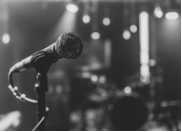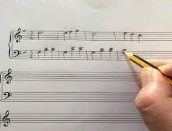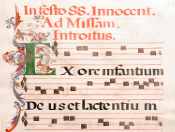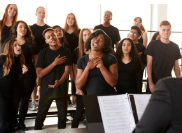The standards for Middle School Choral Music, Intermediate Level enable students to build upon the skills and knowledge acquired at the beginning level. Students continue the development of vocal production techniques, ensemble etiquette, and basic music theory concepts. Opportunities are provided for students to explore choral music as a means of expression and communication. Students apply steps of a creative process to refine ideas and skills in a variety of contexts in choral music. They explore and perform music from a variety of musical styles, composers, cultural influences, and historical periods. Students compare and contrast career options in music and examine the relationship of choral music to the other fine arts. Through the collaborative environment of the choral setting, students develop an understanding of teamwork and leadership skills. Opportunities are provided for students to participate in local, district, and regional music events as appropriate to level, ability, and interest. After-school rehearsal and performances may be required of students.
Essential Question: How do I connect with, respond to, perform, and create music?
|
Quarter |
Quarter 1 |
Quarter 2 |
Quarter 3 |
Quarter 4 |
|
Unit Title |
Finding my voice in Chorus? |
The strength of the foundation determines the quality of the musician. |
The 6 Historical Periods of Music and Beyond |
Strong musical awareness leads to greater exploration. |
|
Image Cue |
 |
 |
 |
 |
|
Focus of the Story |
We begin the year focusing on chorus classroom procedures, routines, and ensemble building using vocal rounds, 2 and 3-part harmony and building our musicianship skills by reviewing key terminology that helps us describe what music looks like and sounds like. We will also be learning how to prepare for an audition and exploring more complex technical skills, while sight-reading and singing new literature. |
We will use body percussion, rhythm dictation exercises, and composition projects to increase the difficulty of our rhythm studies, as well as challenge ourselves with more rigorous sight reading levels and keyboarding skills. We will also prepare and study the historical and cultural context of the Winter Concert repertoire. |
Through the continued study of music literacy, performance, and the discussion of musical time periods, we will examine the relationship of choral music to other fine arts and core subjects. Students may also participate in a District Assessment performance and will be able to reflect, refine and improve their singing based on adjudicator feedback. |
We will continue to focus on increasing the difficulty of rhythm and pitches in sight reading and keyboarding skills. We end the year with a culminating solo project utilizing aural and literacy skills. With their developed skills, the students will prepare and perform the repertoire we will perform in the Spring Concert and a vocal solo. |
|
Transfer Goals |
Understand and apply creative processes to guide the development of ideas, original works, and musical performance. Understand and find meaning in music as a form of community engagement through involvement as a performer, supporter, advocate, and audience member. Explore and connect personal interests, experiences, and aspirations through vocation, advocacy, and arts patronage. Use music literacy to demonstrate understanding of the elements of music and the ways they inform artistic performance and creative expression. |
Understand and apply creative processes to guide the development of ideas, original works, and musical performance. Analyze, interpret, and evaluate musical works from a variety of cultures. Understand and find meaning in music as a form of community engagement through involvement as a performer, supporter, advocate, and audience member. Explore and connect personal interests, experiences, and aspirations through vocation, advocacy, and arts patronage. Use music literacy to demonstrate understanding of the elements of music and the ways they inform artistic performance and creative expression. |
Analyze, interpret, and evaluate musical works from a variety of cultures. Understand and find meaning in music as a form of community engagement through involvement as a performer, supporter, advocate, and audience member. Explore and connect personal interests, experiences, and aspirations through vocation, advocacy, and arts patronage. Use music literacy to demonstrate understanding of the elements of music and the ways they inform artistic performance and creative expression. Use technology as a strategic mechanism for improving music literacy and improving music performance. |
Understand and apply creative processes to guide the development of ideas, original works, and musical performance. Analyze, interpret, and evaluate musical works from a variety of cultures. Understand and find meaning in music as a form of community engagement through involvement as a performer, supporter, advocate, and audience member. Explore and connect personal interests, experiences, and aspirations through vocation, advocacy, and arts patronage. Curate a portfolio of accomplishments, experiences, and performance materials exhibiting oneself as an artist. Use music literacy to demonstrate understanding of the elements of music and the ways they inform artistic performance and creative expression. |
|
Learning Targets |
I can collaborate with my classmates. I can relate to my classmates and define traits we share and those we do not. I can summarize and define the procedures for the chorus classroom. I can recognize, define, and demonstrate proper singing posture. I can define and demonstrate the difference between head voice, chest voice, and falsetto. I can recognize and define the parts of the breathing process. I can follow my part in the vocal score. I can identify and write note and rest values using the Eastman Counting System. I can sing using solfege and Kodaly hand signs. I can perform the District Chorus Audition piece with piano accompaniment I can reflect on my Cornerstone performance. I can perform rhythmic-melodic variations of four to eight measure selections taken from songs, exercises, or etudes. |
I can identify whole steps and half steps on the keyboard. I can sing the rehearsed portions of the concert repertoire. I can rehearse as a member of the ensemble in preparation for the winter concert. I can compose a four measure rhythmic composition. I can define the following musical terms: Timbre,Tone, Balance/Blend & Apply to concert repertoire I can analyze the differences in language of the concert repertoire I can discuss how different languages use sounds to communicate. I can perform on stage with professional etiquette. I can watch a performance with appropriate audience etiquette. I can describe my personal response to music and a performance. I can perform rhythmic patterns using the four levels of body percussion- stomp, pat, clap, and snap. I can dictate rhythms from audiation. I can sight sing 4 measures (DRMFS, quarter notes and rests, beamed 8th notes, half notes and whole notes, with Kodaly Handsigns) and label rhythms using the Eastman Counting System for my cornerstone. |
I can identify the six musical eras in chronological order. I can discuss how music relates to other fine arts. I can listen to a selection of music and discuss the differences in time periods based on the historical style of music.I can evaluate choral performances using key vocabulary. I can identify careers in music. I can articulate the parameters of copyright law and the ethical use of music. I can maintain vocal independence during sight reading. I can critique a recorded performance of choral music using musical terminology for the Cornerstone. I can identify how music creates the whole person as well as how music is valuable to the community. I can discuss the importance of music in my own life. |
I can articulate and demonstrate proper audience etiquette. I can play the correct pitches on a keyboard from notated music. I can articulate and demonstrate professional performance and stage expectations. I can sing concert repertoire while adding appropriate movements. I can sing the concert repertoire with appropriate ensemble technique. I can form personal responses to music and performances. I can perform an eight measure melody on a keyboard. I can outline, plan, and prepare and perform a solo performance. I can respond to peer performances in an appropriate manner. I can reflect on my solo performance. I can reflect on the school year. I can submit a final assessment to display growth over the year. |
